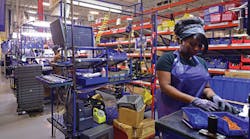2014 IW Best Plants Winner: Plumbing Manufacturing Success at T&S Brass
They get what they want when they want it and it’s good."
That statement from Gary Cole, operations manager at T&S Brass, capsulizes the company’s approach to manufacturing. T&S Brass makes high-quality commercial plumbing products -- brass fixtures that are solid and reliable. The company has over 10,000 products so it can provide a plumber or other customer pretty much whatever they need. And the company prides itself on filling customer orders quickly -- 87% of all sales orders are filled within 24 hours.
At A GlanceT&S Brass and Bronze Works Travelers Rest, S.C. Employees: 264, non-union Total Square Footage: 80,000 Primary Product/Market: Commercial foodservice and plumbing products Start-up Date: 1978 Achievements: 87% of orders shipped within 24 hours; typical manufacturing cycle time of 15 minutes; 98% first pass yield for all products
|
Manufacturing operations include machining of both forgings and castings for faucets and other components. Then these parts go through finishing operations that consist of emery and polishing steps. From there, the parts proceed through an automated racking line where a trivalent nickel chromium finish is applied to the parts. After inspection, the products move to work cells where they are assembled, inspected and packed for shipping.
The focus on fast turnaround was one of the driving forces in the company’s lean journey. Twelve years ago, the plant started to reconfigure its operations for one-piece flow with one manufacturing cell, explaining that the change was being made to make the job easier and simpler.
"They were skeptical at first. No one likes change," Cole recalled. But soon the benefits of the new system were obvious. Over time, 10 cells were set up. These and other changes have allowed the plant to increase its annual sales by more than 80%, yet the production still occurs in the same 60,000-square-foot manufacturing area.
More efficient production and growing sales enabled the company to invest in newer equipment such as CNC machines and vibratory polishing machines. These investments helped the plant score a victory in the struggle to bring manufacturing back from Asia to the U.S.
Production of faucet flanges had moved to China many years ago, but company officials had lost the battle, not the war. They worked with their suppliers to cut material costs. Then they turned their attention to the manufacturing process, installing a CNC machine to produce the flanges. In addition, they attached a pallet changer to ease loading and unloading the machine. The result was a cheaper cost for the flanges, production capacity of 2,500 flanges a day, and no extra inventory to carry because of ocean crossings.
In keeping with its focus on efficiency, T&S Brass recycles everything it can, from cardboard and plastic to the coolant used in machining. In 2014, the plant recycled over 9,000 gallons of coolant. It also collects and sells the metal chips and dust from machining and grinding.
The plant’s veteran workforce plays a major role in its cross-functional continuous improvement teams. No matter what issue they are dealing with, those teams are always focused on three major areas -- productivity, quality and safety. And the dedication to improving the operation doesn’t end when a team completes its work.
"We have had teams that are finished -- made the presentations, got their shirts and free lunch. They still are coming up with new ideas, even though the team has been finished for years," Cole reports.




